12+ Awesome Tips To Reduce Cart Abandonment for eCommerce in 2024
Shopping cart abandonment is disappointing for eCommerce companies. It’s hard to attract some potential shoppers, see them add items to their cart… and then watch them leave before finalizing the purchase. My heart is already broken imagining this.
However, there are two ways for you to look at this.
Option A is to get angry and say, “Look at all these fools who didn’t buy from our store even having products in their carts! Why? People are weird.”
Option B is to calm down and think, “Look like we still have more room for growth with all these potential customers! We can increase our revenue a good deal if we are able to get this problem fixed.”
If you’re up for Option B, then this article is for you, and I’m with you, fams. Cart abandonment is a valuable opportunity for eCommerce brands. There are many effective ways for you to convert more of your shoppers into buyers or even loyal customers.
What is cart abandonment?
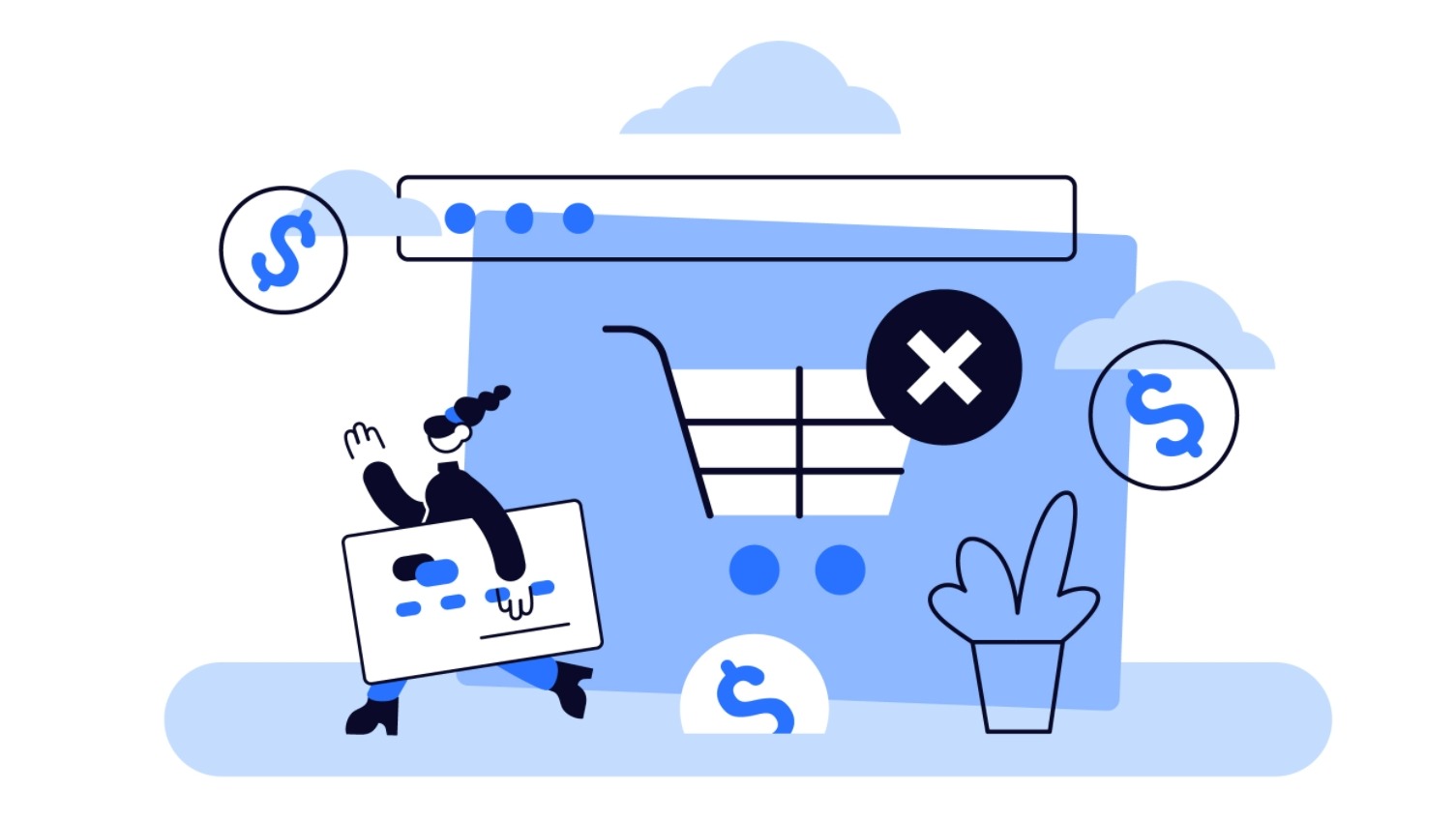
For eCommerce companies, cart abandonment is when an existing or potential customer adds a product to their shopping cart, only to exit the site and doesn’t make a purchase.
There are many possible reasons for cart abandonment. Someone can browse through your product offerings, lay an eye on what they wanted, and then add it to their online shopping cart. But right before they check out, something happens. Their internet goes down. Their kids need them to pick up. They got distracted from browsing Instagram.
The result is that they never completed the order. The selected product(s) remains in the cart until your eCommerce site automatically clears their order — or you somehow successfully encourage them to come back and finish the checkout process.
Now, cart abandonment is sometimes confused by people with other types of abandonment, so I want to clear that up real quick with these definitions:
-
Browsing abandonment is when a visitor views a product but doesn’t add it to the shopping cart.
-
Cart abandonment is one step further than browsing abandonment. It’s when a potential buyer adds an item to their cart but then stops going any further.
-
Checkout abandonment is when a potential buyer adds an item to their cart, goes down the checkout path and insert their information, but then abandons purchasing before submitting their payment and order.
Shopping cart abandonment rate is an essential business metric for eCommerce retailers to monitor, as it can strongly affect the customer conversion rates and overall revenue. A high cart abandonment rate is often viewed as an indicator of faults in your checkout process or shopping experience.
Cart abandonment statistics
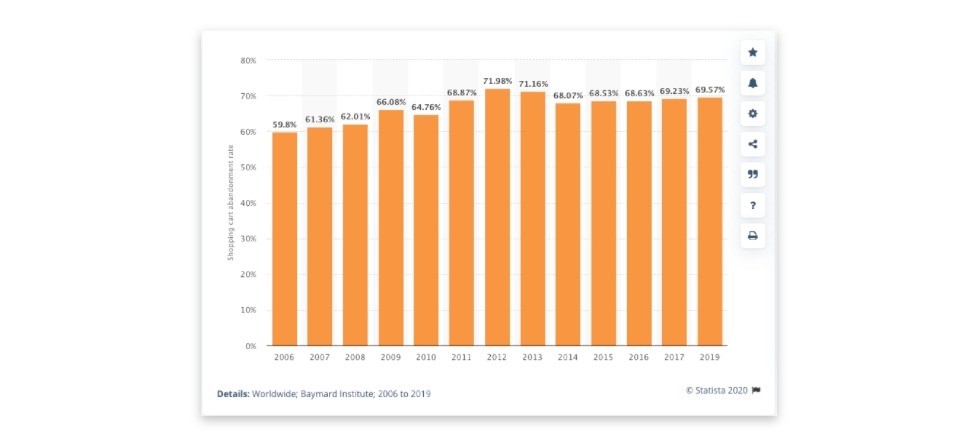
Shopping cart abandonment is one of the largest obstacles for eCommerce retailers to overcome. The extent of the problem is actually overwhelming when I researched for the cart abandonment statistic.
According to data from a retail marketing company that tracks shopping cart abandonment, 81% is the average rate at which average consumers abandon the shopping carts before making a purchase. During the first six-month period of the year, the average cart abandonment rate is 75%.
Which means, in the best-case scenario, most eCommerce stores lose at least three-fours of shopping carts as users add products to cart but fail to cross the line and convert. It also means that, in the worst case, four in every five consumers is leaving their cart before actually purchasing anything.
In a high-competing environment like eCommerce and an unexpected time during the pandemic, the rate for cart abandonment can actually even rise higher.
Here’s some sobering data for eCommerce marketers to look at abandoned carts in a new eye:
-
Completion rates on tablets and desktop is around 13% - but mobile purchase completion rates stand at only 8.5%
-
The travel industry has one of the highest abandonment rates compared to any ecommerce sector, at almost 85%.
-
The average shopping cart abandonment rate during checkout is as high as 87%, and this metric rises on Fridays and weekends - as high as nearly 90%
Ideally, you want to optimize your cart abandonment rate so it is as low as possible. The benchmark for average performance among industries is a good comparison point to start. If your cart abandonment rate is around the number of your industry, a little bit of optimization will help you on the way to having a higher conversion rate in no time.
How to calculate the cart abandonment rate
Cart abandonment rate is often calculated as a percentage. It signals store owners what percent of the total number of visitors add items to their carts, but fail to complete the checkout process.
Here is how that math for cart abandonment rate works:
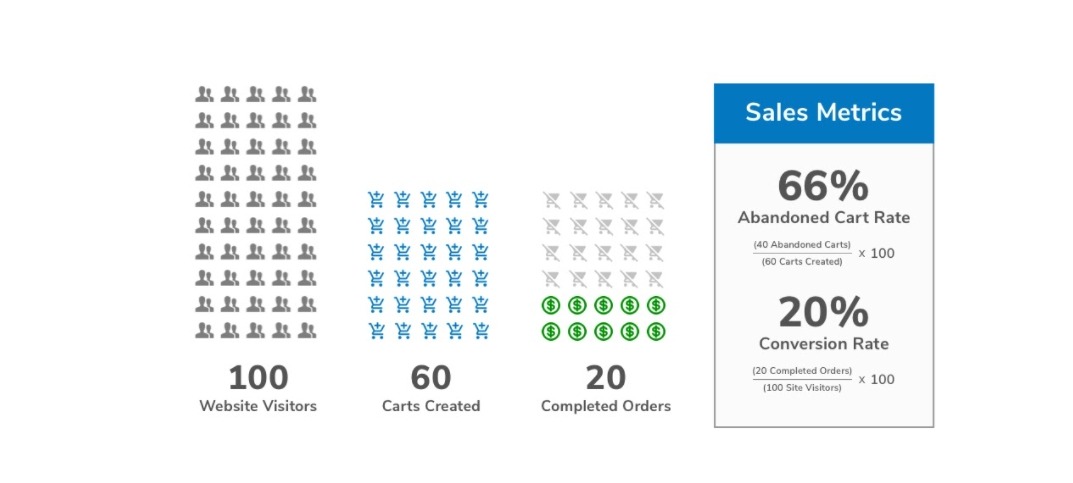
Basically, you take the number of abandoned shopping carts and divide it by the total number of created carts, then multiply with 100 to get the cart abandonment rate. If you want to know the conversion rate of your eCommerce store, simply take the number of completed orders and divide by the number of site visitors, then multiply that number with 100.
So, let’s assume that your online store gets 1000 visitors this month. Let’s also assume that 300 of those visitors added at least one item to the shopping cart.
Most of these 300 shoppers won’t actually complete purchasing. They will get distracted by something in their lives, go look for a better discount code, or just “save the product for later.”
Let’s assume that 150 of those shoppers actually complete their purchase, though. 300 shopping carts were created, but 150 of them were never actually finished, which means you have about 66% of the shoppers leaving without completing the order.
That’s a lot of money you could have got if they finished buying the products in the cart. Well, you may be surprised to learn that a 50% cart abandonment rate is pretty fantastic compared to industry averages. As mentioned, 81% is the common cart abandonment rate among all eCommerce companies.
But, how do you know if your cart abandonment rate is actually good or not?
A good cart abandonment rate is one that’s always improving. As long as you see the number getting smaller, your business is still improving with the check out process. You have a good cart abandonment rate if it is lower than that of last month.
To find your rate, you can use tools like Google Analytics or your platform analytics. Shopify or BigCommerce lets you quickly access the cart abandonment numbers in their Report page. For other platforms, you may need to install a plugin to calculate the cart abandonment rate.
Top reasons for cart abandonment
A confusing checkout process and a lack of transparency for elements like return policies and shipping costs are some of the main reasons for shopping cart abandonment.
The bad news is that nooen can ever be able to fully eliminate cart abandonment. But if you understand what’s causing shoppers to abandon their carts and being proactive about fixing trouble spots, you can protect your conversion rate.
Let’s see some of the more specific reasons for shopping cart abandonment.
-
Long and confusing checkout process: Buyers want to cross the finish line quickly and avoid any convenience during the buying process. A confusing checkout process with unnecessary steps and multiple form fills can slow shoppers down and turn them away.
-
Unexpected shipping costs: If a shopper has entered the shipping information only to find out that there are additional charges that they don’t anticipate, they may reevaluate their purchase and abandoned carts if they feel they are being tricked.
-
Mandatory account creation: Requiring visitors to create an account before purchasing is an unnecessary barrier since first time shoppers may not be ready to create an account yet.
-
Payment security concerns: Most buyers are cautious about online payment and secured transactions. You don’t want to look like a fraud store in their eyes.
-
Comparison shopping: Customers nowadays have access to many resources of information when shopping online and can compare product options quickly, so they may leave carts when they find a better deal.
-
Restrictions on product quantity: If buyers find out in the check out process that they can’t actually purchase because of restrictions on the quantity each person can purchase, they may abandon the cart feeling frustrated.
-
Lack of payment options: Online consumers want to buy with payment methods that are most convenient. Paypal, Apple pay, cash on delivery, are some common payment methods you should have.
-
Unexpected delivery times: Buyers expect their products to arrive in a reasonable time. If they know they need to wait too long, they can easily find another retailer with a better shipping time.
-
Ambiguous return and refund policy: An ambiguous or insufficient return policy can cause buyers to second guess their purchase. Consumers want to know that they can easily return the product should anything go wrong.
-
No discounts and promo codes: Many buyers only buy if they see the discounts, or find that other eCommerce retailers have better discounts.
-
Site speed and performance issues: A unstable and buggy eCommerce site can cause buyers to lose confidence in the checkout process - or to just feel frustrated and abandon the cart.
12 Awesome tips to reduce cart abandonment

Now that we know better about cart abandonment, let’s see the best tip to reduce cart abandonment. There are many ways for you to make visitors purchase their products more, from optimizing the check out process to sending cart abandonment emails. Let’s see all of these tips for reducing cart abandonment rate in this section.
#1. Be transparent about costs
You should give your customers all costs upfront, including any costs of shipping, what taxes apply, and any other fees the consumers should expect. This way, you reduce the likelihood that the extra costs would catch shoppers off guard and unexpectedly increase the price.
Right at the checkout page, list out all the costs that are associated with purchasing the product. Buyers will only need to think about spending the money or not and they would be quicker about their decision thanks to your information.
#2. Include pictures of products during the checkout
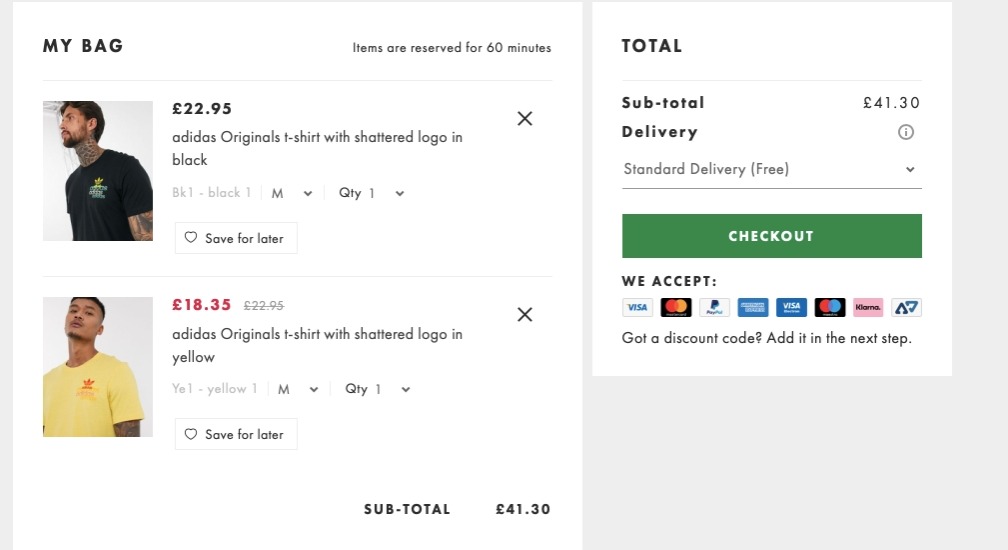
Including thumbnails of products during the checkout process can be a good way to reassure customers of the products they are about to purchase.
When buying in person, customers can see and feel the products they are buying — something they can’t have during an online purchase. Including product thumbnails are useful to keep these products top of mind of the customers during the entire checkout process.
#3. Make navigation between store and cart effortless
Consumers want to quickly add items to the shopping cart and get back to other activities or browsing the rest of your inventory in a convenient way. The more work you make your visitors do, the less likely they will continue to buy the products in their carts.
Design your website so it is effortless for your customers to add items into their cart and quickly continue browsing until they’re ready to buy. Many eCommerce retailers have made it possible for buyers to checkout directly from a product page to minimize the steps, clicks, and page views necessary to complete the purchase.
#4. Optimize load speed
You don’t want your customers to question if their order was successfully completed or not. Having a fast loading page is essential to satisfy your buyers’ demand for a speedy purchasing experience. Not only can you make your customers happier with a fast loading website, they are also more likely to buy additional products from your eCommerce store because they don’t have to wait long for buying.
#5. Offer live chat support
An added benefit of shopping in-store is that you can talk to friendly staff who are ready to assist you find items or answer any of your questions.
For an eCommerce store, you can mirror this same level of attention and care by integrating live chat customer support options into your checkout flow. With cart abandonment data, you can identify areas where buyers are more likely to drop off and allow consumers to chat with a support rep and reduce cart abandonment.
#6. Send cart abandonment emails
Abandoned cart emails are follow-up messages which target the consumers who leave your website website without buying the products in the online shopping cart.
You can remind shoppers that they haven’t completed the purchase and give them the option to pick up where they left off. If you want to streamline the process, include a link in the emails that takes recipients to the exact stage they left before buying. Having a small discount is also efficient to entice shoppers to revisit their carts.
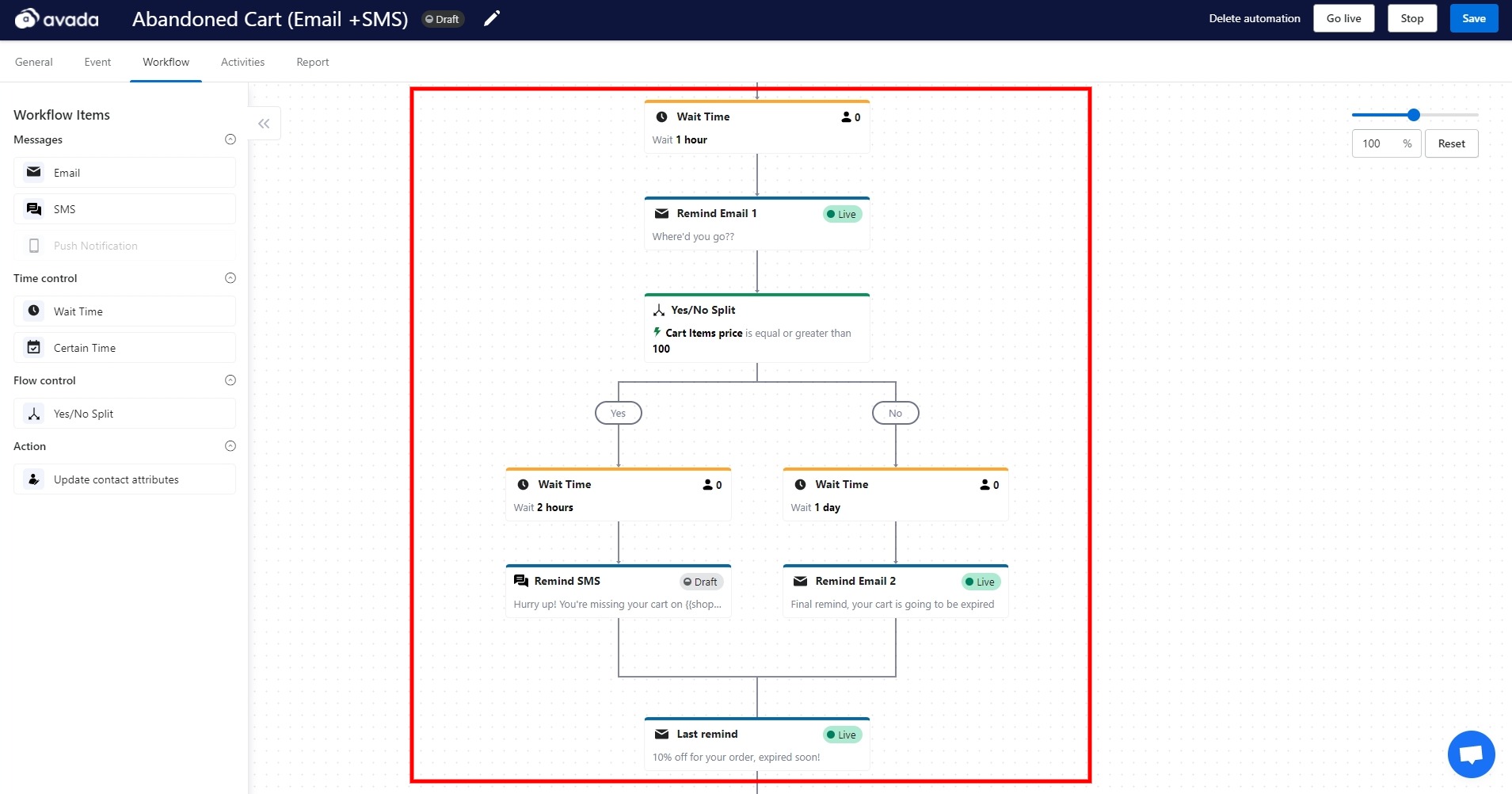
With AVADA Email Marketing, you have built-in cart abandonment email sequences so you can have automated emails that recover carts for you. You can also edit the emails based on the cart worth and products to personalize the messages, combining with SMS (will be mentioned below) to reach the consumers even better.
Read more: What Are Abandoned Cart Email? Guideline!
#7. Use SMS to remind customers
If the consumers have given you their phone number and agreed to receive texts from you, you can also leverage SMS to remind them about the abandoned carts and convince them to purchase.
Abandoned cart SMSs often require fewer design, images, and formatting than emails, though you should still set up your SMS messages to be personalized, pointed, timely, and simple.
Keep in mind that SMS messages ideally work with the email campaigns to provide a cohesive cart reminder experience. For example, you can send an abandoned cart email a few hours after the customer leaves the cart and follow up one day later with an SMS, before the cart or your discount offer expires.
Also, you guessed it right! You can set up email and SMS marketing campaigns together in AVADA Email Marketing.
#8. Have guest checkout options
Locking the user from purchasing behind a signup wall can make new visitors leave from your site. If you want to make sure that you’re not missing out on any potential customers, offer consumers the ability to check out as a guest instead of forcing them to create an account.
On the other hand, to collect emails and contact information for future promotional purposes, you can prompt consumers to share the checkout information at their confirmation page step. This way, they can give information only when having decided to purchase.
#9. Offer a money-back guarantee
Uncertainty and hesitation are the mortal enemies for eCommerce companies. The more you can do to either overcome potential objections or continually reassure consumers, the more likely you will see your conversion rates increase. One efficient way to overcome hesitation in the purchasing journey of buyers is by offering money-back guarantees to assure potential customers.
If you can offer a no-questions-asked money-back guarantee, you can greatly reduce the potential objections a consumer might have about buying from your store. It shifts the focus from terms of sale and prices to the actual product. If a customer does have hesitation about buying from you, it shouldn’t be because of the fear of losing their money.
#10. Use trust symbols
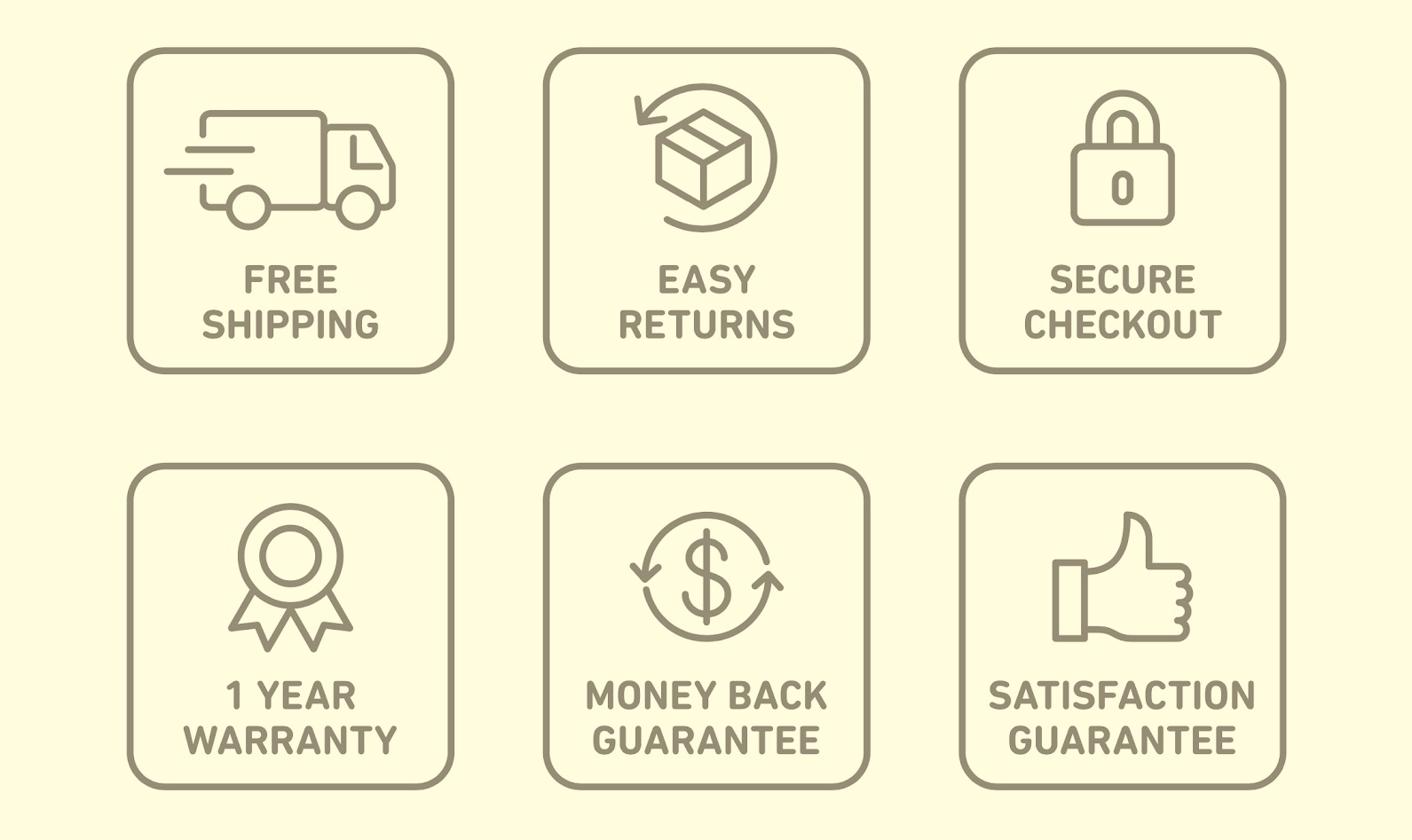
Buyers want to know if your store is secure when they share sensitive personal information like credit card number or shipping address. One tactic to build customer confidence in your eCommerce site is by displaying security seals throughout the checkout process.
Having PCI-DSS compliance and other safety badges can help reassure consumers that their profile and personal details will be kept safe through order completion.
Read more: 10+ Trust Badges That Can Increase Your Conversion Rate
#11. Invest in ads for retargeting
Another way to bring potential buyers back to their cart is by using retargeting ads. You can use tracking pixels or your site’s cookies (work with your developers here) to make your brand or products in cart resurface on the customer’s environment like:
-
Social media feeds
-
Future related Google searches
-
Sidebars of other sites
Retargeting cart abandoners with relevant ads will keep the items they viewed or items in their cart top of mind. With the ads, you will be able to spur your prospects to purchase by reminding them about what they left in the shopping cart.
#12. Have several payment options
Having a single payment option — or too few options— can put unnecessary obstacles between your shoppers and purchasing. Today’s buyers have access to many advanced payment options including direct digital wallets, credit cards, and bank transfers.
Offering support for some popular payment options, particularly the ones mostly used by your target audience, can help ensure you’re not losing good customers. To have a particularly higher AOV (average order value) for carts, you can consider allowing buyers to purchase using other financing options.
Final words
While every eCommerce store has different customer segments, many consumers have somewhat similar preferences and buying habits. One thing is common: frustrating and time-consuming checkout experiences are likely to cause shoppers to abandon their carts.
To succeed in the experience-driven world of today, online retailers must keep prioritizing stellar purchase experiences to convert these cart abandoners into paying customers. Make sure to check out our other guides on the topic of cart abandonment to have the full understanding:
New Posts

How To Set Up Google Analytics 4 For Your BigCommerce Store






